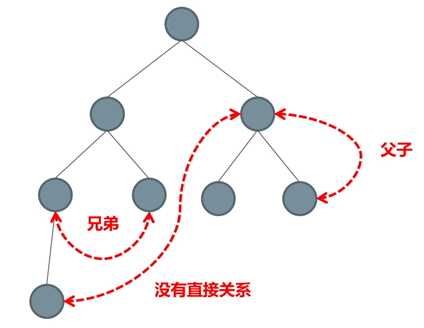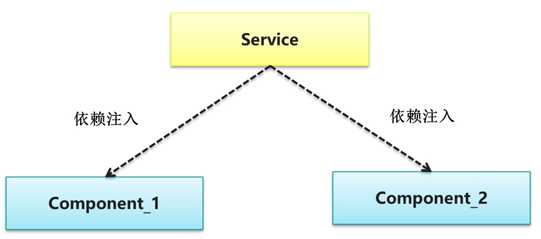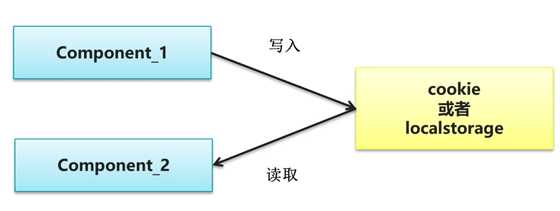目录
1 前言
2 Angular组件间的通讯
2.1 父子组件间的通讯
2.1.1 父组件设置子组件属性
2.1.2 父组件调用子组件事件
2.1.3 子组件向父组件发射事件
2.2 非父子组件通讯
2.2.1 Service
2.2.2 路由传值
2.2.2.1 传递一个值
2.2.2.2 传递一个对象
3 通用方式实现通讯
3.1 localStorage
3.2 服务端
4结语
1前言
前端框架,例如extjs,vue,angular等,都是或趋于组件化,所以组件间的通讯,是一个亟需解决的问题
一般而且言,这些组件之间都会形成这种树形结构

图片来源:大漠穷秋
组件之间会有下列3种关系:
1父子关系
2兄弟关系
3没有直接关系
通常采用下列方式处理(某些方式是框架特有)组件间的通讯,如下:
1父子组件之间的交互(@Input/@Output/模板变量/@ViewChild)
2非父子组件(Service/localStorage)
3还可以利用Session等服务器端的解决方法
2Angular组件间的通讯
2.1父子组件之间的通讯
在父子组件之间通讯:
@Input:是属性绑定,父组件向子组件传递数据
@Output:是事件绑定,子组件向父组件传递数据的同时触发事件
2.1.1在父组件设置子组件上面的的属性
通过@input绑定子组件的属性,注意属性得是公开public的,私有private属性是无法传递的
es6新语法get/set.为属性提供了一个方便习惯的读/写方式, 拦截属性的存取行为。
在父组件设置该属性,就能够通过set方法来修改,从而实现在父组件设置子组件属性
代码如下

1 <h1>{{childTitle}}</h1>

1 import { Component, OnInit, Input } from ‘@angular/core‘; 2 3 @Component({ 4 selector: ‘app-child‘, 5 templateUrl: ‘./child.component.html‘, 6 styleUrls: [‘./child.component.sass‘] 7 }) 8 export class ChildComponent implements OnInit { 9 10 private _childTitle: string = ‘子组件标题‘; 11 12 @Input() 13 set childTitle(childTitle: string) { 14 this._childTitle = childTitle; 15 } 16 get childTitle(): string { 17 return this._childTitle; 18 } 19 20 constructor() { } 21 22 ngOnInit() { 23 24 } 25 }

1 <p> 2 parent-and-child works! 3 </p> 4 <app-child childTitle="可设置子组件标题"></app-child>

1 import { Component, OnInit } from ‘@angular/core‘; 2 3 @Component({ 4 selector: ‘app-parent‘, 5 templateUrl: ‘./parent-and-child.component.html‘, 6 styleUrls: [‘./parent-and-child.component.sass‘] 7 }) 8 export class ParentAndChildComponent implements OnInit { 9 10 constructor() { } 11 12 ngOnInit() { 13 14 } 15 16 }
2.1.2父组件直接调用子组件的方法
通过模板内部定义子组件变量,在父组件上可以直接调用子组件的方法,如下:

1 <p>child work</p>

1 import { Component, OnInit, Input } from ‘@angular/core‘; 2 3 @Component({ 4 selector: ‘app-child‘, 5 templateUrl: ‘./child.component.html‘, 6 styleUrls: [‘./child.component.sass‘] 7 }) 8 export class ChildComponent implements OnInit { 9 constructor() { } 10 11 ngOnInit() { 12 13 } 14 15 childPrint() { 16 alert("来自子组件的打印"); 17 } 18 }

1 <p> 2 parent-and-child works! 3 </p> 4 <app-child #child></app-child> 5 <button (click)="child.childPrint()"></button>

1 import { Component, OnInit } from ‘@angular/core‘; 2 3 @Component({ 4 selector: ‘app-parent‘, 5 templateUrl: ‘./parent-and-child.component.html‘, 6 styleUrls: [‘./parent-and-child.component.sass‘] 7 }) 8 export class ParentAndChildComponent implements OnInit { 9 10 constructor() { } 11 12 ngOnInit() { 13 14 } 15 16 }
2.1.3父组件接受子组件派发的事件
通过@Output在子组件绑定一个事件发射器,在父组件通过事件绑定监听该事件
这样在子组件派发一个事件,父组件就能够收到

1 <p>child work</p>

1 import { Component, OnInit, Output, EventEmitter } from ‘@angular/core‘; 2 3 4 @Component({ 5 selector: ‘app-child‘, 6 templateUrl: ‘./child.component.html‘, 7 styleUrls: [‘./child.component.sass‘] 8 }) 9 export class ChildComponent implements OnInit { 10 11 @Output() 12 initEmit = new EventEmitter<string>(); 13 14 constructor() { } 15 16 ngOnInit() { 17 this.initEmit.emit("子组件初始化成功"); 18 } 19 }

1 <p> 2 parent-and-child works! 3 </p> 4 <app-child (initEmit)="accept($event)"></app-child>

1 import { Component, OnInit, Output, EventEmitter } from ‘@angular/core‘; 2 3 @Component({ 4 selector: ‘app-parent‘, 5 templateUrl: ‘./parent-and-child.component.html‘, 6 styleUrls: [‘./parent-and-child.component.sass‘] 7 }) 8 export class ParentAndChildComponent implements OnInit { 9 10 constructor() { } 11 12 ngOnInit() { 13 14 } 15 accept(msg:string) { 16 alert(msg); 17 } 18 }
2.2没有直接关系的组件
2.2.1service
做一个全局单例的service,然后多个组件共享这个实例,当然就可以共享其中的成员,来进行通讯

图片来源:大漠穷秋
具体代码如下

1 import { Component, Injectable, EventEmitter } from ‘@angular/core‘; 2 @Injectable() 3 export class myService { 4 public info:string = ‘‘; 5 constructor() {} 6 }
在app.module.ts文件的providers里添加这个服务

1 <p>child1 work</p> 2 3 <button (click)="showInfo()"></button>

1 import { Component, OnInit} from ‘@angular/core‘; 2 import { myService } from ‘../../../service/myService..service‘; 3 4 5 @Component({ 6 selector: ‘app-child‘, 7 templateUrl: ‘./child1.component.html‘, 8 styleUrls: [‘./child1.component.sass‘] 9 }) 10 export class Child1Component implements OnInit { 11 12 constructor( 13 public service: myService 14 ) { } 15 16 ngOnInit() { 17 18 } 19 showInfo() { 20 alert(this.service.info); 21 } 22 }

1 <p> 2 child2 works! 3 </p> 4 <button (click)="changeInfo()"></button>

1 import { Component, OnInit} from ‘@angular/core‘; 2 import { myService } from ‘../../service/myService..service‘; 3 4 @Component({ 5 selector: ‘app-child2‘, 6 templateUrl: ‘./child2.component.html‘, 7 styleUrls: [‘./child2.component.sass‘] 8 }) 9 export class Child2Component implements OnInit { 10 11 constructor( 12 public service: myService 13 ) { } 14 15 ngOnInit() { 16 17 } 18 changeInfo() { 19 this.service.info = this.service.info + "1234"; 20 } 21 }
2.2.2路由传值
对于2个不同路由的组件,我们也可以通过路由传递信息
假设2个路由分别为~/home,~/about
2.2.2.1传递一个值
假如从~/home路由向~/about路由传递一个字符串或数字
1先把~/about的路由地址改为~/about/:id
2在/home写上路由跳转且传值的连接
1 <button [routerLink]="[‘/about‘,1]">跳转</button> 2 <button [routerLink]="[‘/about‘,"home"]">跳转</button>
3在跳至的页面~/about接受传入的值
1 id: string = ‘‘; 2 3 ngOnInit() { 4 //获取传入的值 5 this.id = this.route.snapshot.params[‘id‘]; 6 }
2.2.2.2传递一个对象
类似于上述的传递一个值,但是不需要再路由末尾加上/:id
代码也有些不同
1 <button [routerLink]="[‘/about‘]" 2 [queryParams]="{id:12,status:true}">跳转</button>
接受传入的对象
1 id: number = 0; 2 status: boolean = false; 3 ngOnInit() { 4 this.route.queryParams 5 .subscribe((params: Params) => { 6 this.id = params[‘id‘]; 7 this.status = params[‘status‘]; 8 }) 9 }
3通用方式实现通讯
3.1localstorage处理
在angular中也可以使用本地存储这种比较通用的方式在组件间通讯,但本地存储有下列弊端:
1存储空间有限
2只能存储字符串

图片来源:大漠穷秋
具体的实现代码如下

1 import { Component, OnInit } from ‘@angular/core‘; 2 3 @Component({ 4 selector: ‘app-child1‘, 5 templateUrl: ‘./child1.component.html‘, 6 styleUrls: [‘./child1.component.sass‘] 7 }) 8 export class Child1Component implements OnInit { 9 10 constructor() { } 11 12 ngOnInit() { 13 14 } 15 16 setData(){ 17 window.localStorage.setItem("test", JSON.stringify({ key: ‘test‘, value: 1 })); 18 } 19 }

1 import { Component, OnInit } from ‘@angular/core‘; 2 3 @Component({ 4 selector: ‘app-child2‘, 5 templateUrl: ‘./child2.component.html‘, 6 styleUrls: [‘./child2.component.sass‘] 7 }) 8 export class Child2Component implements OnInit { 9 10 constructor() { } 11 12 ngOnInit() { 13 14 } 15 16 getData() { 17 var json = window.localStorage.getItem("test"); 18 var obj = JSON.parse(json); 19 console.log(obj.key); 20 console.log(obj.value); 21 } 22 } 23 24 25 26 27 28 29
服务端处理
也可以在服务端来处理组件间的通讯问题,这是一个思路,但是已经脱离讨论的主题,就不赘述
4结语
本文是对angular里组件间的通讯做一个简单的系统的归纳,其中很多细节可以自成一篇文章的,出于篇幅和能力的原因,文章中没有详尽描述
对于文章中的错误或不足之处,欢迎指正
学习参考资源(大漠穷秋):http://www.ngfans.net/topic/12/post/2
出自:博客园-半路独行
原文地址:https://www.cnblogs.com/banluduxing/p/9290569.html
本文出自于http://www.cnblogs.com/banluduxing 转载请注明出处。
原文:https://www.cnblogs.com/banluduxing/p/9290569.html